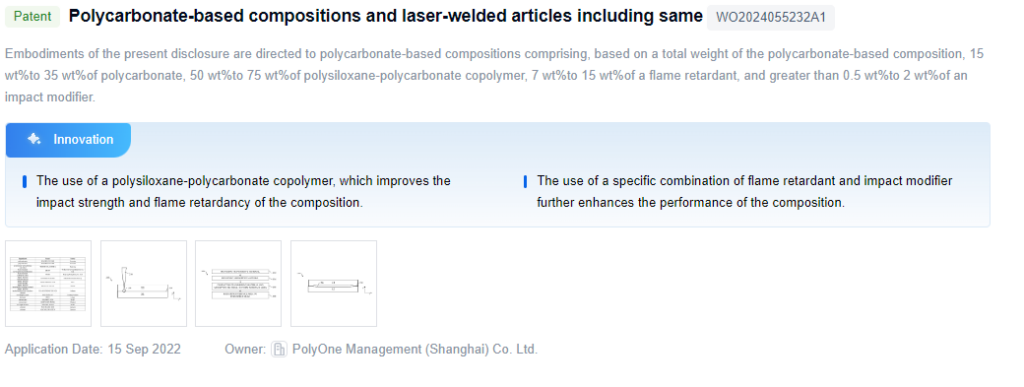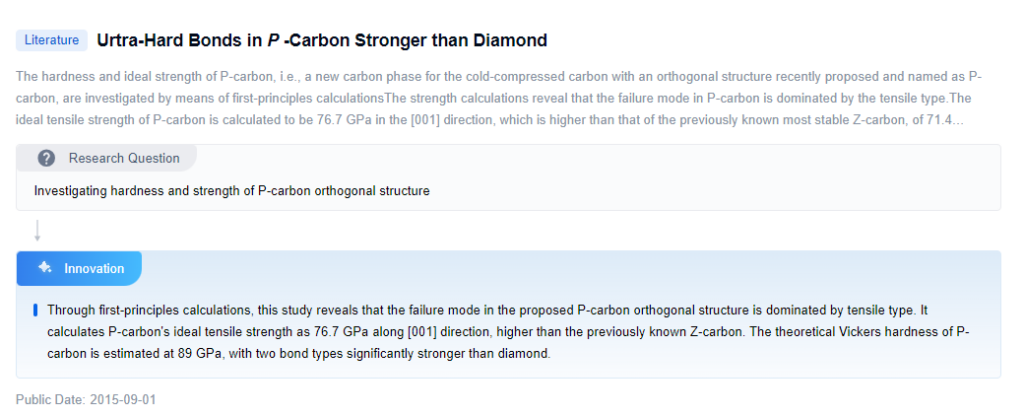
Polycarbonate Toughness Background and Goals
Polycarbonate is a widely used engineering thermoplastic known for its impact resistance, transparency, and heat resistance. However, its inherent brittleness and low resistance to crack propagation limit its applications in areas requiring high toughness. The goal is to improve the toughness of polycarbonate, which means enhancing polycarbonate’s resistance to impact, fracture, and crack propagation, thereby expanding its potential applications in industries like automotive, construction, and consumer electronics. Achieving this would lead to more durable and safer products while maintaining polycarbonate’s desirable properties, such as optical clarity and thermal stability.
Researchers have explored various strategies to improve toughness, including chemical modifications, blending with other polymers or elastomers, and incorporating nanofillers or reinforcing agents. Enhancing toughness has significant implications for product design, safety, and sustainability, leading to products that can withstand higher impact loads, reduce failure risks, and increase product lifespan.

To get a detailed scientific explanations of polycarbonate, try Eureka.
Market Demand for Durable Polycarbonate Products
The demand for durable polycarbonate products is rising across multiple sectors due to the need for lightweight, shatter-resistant, and long-lasting materials. Polycarbonate is extensively used in the automotive industry for headlights, taillights, and exterior components, driven by the emphasis on vehicle safety and advanced lighting technologies.
In construction, polycarbonate is in demand for shatterproof windows, skylights, and roofing systems due to its insulation properties, UV resistance, and durability. The electronics and consumer goods sectors use polycarbonate for durable housings, protective cases, and displays, with the growing demand for lightweight, shatter-resistant products. The rise in outdoor recreational activities has also fueled the market for polycarbonate in protective gear, helmets, and other safety equipment.
Automotive and Aerospace Sectors
- Automotive manufacturers rely on polycarbonate for impact-resistant, lightweight components like headlights and exterior parts.
- Aerospace applications favor polycarbonate for its fire resistance, low smoke emission, and high strength-to-weight ratio.
Electronics and Consumer Goods
- Polycarbonate’s durability makes it ideal for protective cases, housings, and displays in electronics.
- The material is favored for its shatter resistance and lightweight properties.
Sustainability Considerations
- Polycarbonate’s recyclability and potential for reuse contribute to its appeal as an eco-friendly material.
- The demand for durable, long-lasting products aligns with the push for sustainability.
Current State and Challenges in Polycarbonate Toughness

Despite its advantages, polycarbonate’s brittleness, especially at low temperatures, remains a significant challenge. The rigid molecular structure limits energy dissipation, making the material prone to failure under stress. Additionally, defects such as voids, inclusions, or surface flaws act as stress concentrators, increasing the likelihood of crack propagation.
Key Challenges:
- Inherent Brittleness: Polycarbonate’s rigid structure leads to brittleness, particularly under low temperatures, increasing the risk of catastrophic failure.
- Defects and Anisotropy: Manufacturing defects and the anisotropic nature of polycarbonate can lead to unpredictable failure modes.
- Additive Compatibility: The challenge of achieving uniform dispersion and good interfacial adhesion of additives and reinforcements within the polycarbonate matrix.
Global Research Efforts
- Research is ongoing worldwide to address these challenges, with regions boasting advanced manufacturing capabilities leading the way in material development and processing techniques.
Evolution of Polycarbonate Toughening Technologies

Existing Solutions for Enhancing Polycarbonate Toughness
Polycarbonate Compositions with Improved Toughness
Various compositions blend polycarbonate with other polymers, such as thermoplastic polyurethanes or rubbers, to enhance impact resistance and low-temperature toughness.
Impact-Modified Polycarbonate Compositions
These include impact modifiers to improve stress and strain resistance, allowing polycarbonate to withstand higher impacts without fracturing.
Thermally Stable Polycarbonate Compositions
These formulations incorporate additives to maintain mechanical properties and dimensional stability at higher temperatures.
Reinforced Polycarbonate Compositions
Incorporating fibers or fillers like glass or carbon fibers enhances the strength, stiffness, and dimensional stability of polycarbonate, making it suitable for structural applications.
Key Players in Polycarbonate Industry
The competitive landscape for enhancing polycarbonate toughness includes both industry leaders and emerging players, all investing heavily in R&D to improve material properties.
Kingfa Sci. & Tech. Co. Ltd.
Kingfa Sci. & Tech. Co. Ltd. has developed a polycarbonate blend with impact modifiers, improving toughness by incorporating elastomeric materials that enhance impact resistance and durability.
Wanhua Chemical Group Co. Ltd.
Wanhua Chemical Group Co. Ltd. focuses on polycarbonate composites with advanced polymer blending techniques, integrating nano-fillers to boost mechanical properties.
ExxonMobil Chemical Patents Inc.
ExxonMobil Chemical Patents Inc. has introduced a polycarbonate formulation with specific additives that interact with polymer chains, increasing flexibility and impact resistance.
SABIC Global Technologies BV
SABIC Global Technologies BV has developed a high-performance polycarbonate using a unique copolymerization process, incorporating monomers that enhance toughness and durability.
Covestro Deutschland AG
Covestro Deutschland AG has created a polycarbonate blend with advanced impact modifiers, optimizing their dispersion to achieve superior impact resistance.
Core Innovations in Polycarbonate Toughening
Patent 1: Polycarbonate-Based Compositions and Laser-Welded Articles
This patent describes a composition with a polysiloxane-polycarbonate copolymer that improves impact strength and flame retardancy, using a combination of flame retardant and impact modifier for enhanced performance.

Patent 2: Polycarbonate Composition and Manufacturing Methods
A polycarbonate composition with specific weight percentages of bisphenol A homopolycarbonate and polycarbonate-siloxane copolymer, resulting in improved aesthetics, flame retardance, and chemical resistance.

Paper 1: Ultra-Hard Bonds in P-Carbon
Through first-principles calculations, this study reveals that the P-carbon orthogonal structure has a tensile strength of 76.7 GPa along the [001] direction and a theoretical Vickers hardness of 89 GPa, stronger than diamond.

Potential Breakthroughs in Polycarbonate Toughness
Polycarbonate Compositions with Improved Toughness
Development of compositions with impact modifiers and rubber-based additives to enhance overall toughness and durability.
Flame-Retardant Polycarbonate Compositions with High Toughness
Formulations that combine fire resistance with high impact strength and toughness.
Polycarbonate Alloys and Blends
Alloying polycarbonate with other polymers like ABS to create composites with enhanced toughness and impact resistance.
Reinforced Polycarbonate Composites
Use of glass, mineral, or carbon fibers to improve toughness and impact resistance while maintaining stiffness and dimensional stability.
Polycarbonate with Improved Low-Temperature Toughness
Compositions designed to enhance toughness and resistance to brittle fracture at low temperatures.
Environmental Impact of Polycarbonate Production
Polycarbonate production involves significant environmental concerns, such as greenhouse gas emissions, hazardous waste, and resource extraction impacts. Emissions from fossil fuel use, hazardous byproducts, and the extraction of materials like bisphenol A (BPA) contribute to environmental degradation. Strategies to mitigate these impacts include adopting cleaner production technologies, exploring bio-based or recycled materials, and improving waste management practices.
Regulatory Landscape for Polycarbonate Materials
Polycarbonate materials are subject to various regulations to ensure safety and environmental protection. In the U.S., the EPA and OSHA regulate environmental impact and worker safety, respectively. The EU’s REACH regulation requires safety evaluation of chemical substances, including polycarbonate materials. Compliance with these regulations is essential, as non-compliance can lead to fines, product recalls, and reputational damage. Companies must stay informed about emerging regulations and contribute to the development of responsible practices.
If you want an in-depth research or a technical report, you can always get what you want in Eureka Technical Research. Try now!

